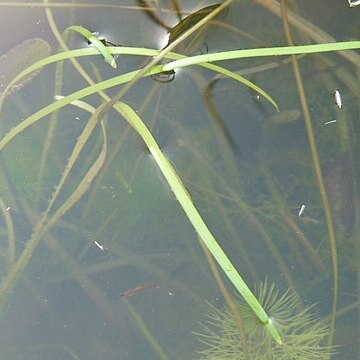A plant which grows under water but attached to the bottom. Plants are separately male and female. They form stolons or runners which develop tufts of leaves along them. They also develop roots along this creeping stem. The leaves are narrow and like ribbons. They can be 1 m long and 1-2 cm wide. They form sheaths at the base. Sometimes there are fine brown lines along the leaves. The male flowers are very small and have a flower stalk up to 7 cm long. The female flowers are 1.5-2.5 cm across and on flower stalks 1 m long. This allows the flower to reach the water surface but once pollinated the fruit develops below water. Male flowers detach and float to the water surface allowing pollen to be released. The female flower has 3 sepals and 3 petals. The ovary is 17-25 mm long and split into 2 broad lobes. The fruit is greenish-yellow with black or brown stripes. The fruit can be 6-20 cm long.
Rhizome tuberous; stolons ca. 2 mm in diam., usually smooth. Leaves 0.2-2 m × 0.5-2 cm, veins 5-9, margin entire or inconspicuously serrulate, apex obtuse. Male spathe ovate-conic, 1.5-2 cm × 5-10 mm, with more than 200 male flowers; sepals strongly convex; stamens 1, filaments sometimes 2-lobed at apex, with hairs at base. Female spathe 1.5-2 cm; peduncle 30-50 cm or longer, slender; sepals greenish purple, 2-4 × ca. 3 mm, apex obtuse; petals white, minute; staminodes 3. Fruit cylindric, 5-30 cm × ca. 5 mm. Seeds narrowly obovoid, glandular hairy. 2n = 20.


